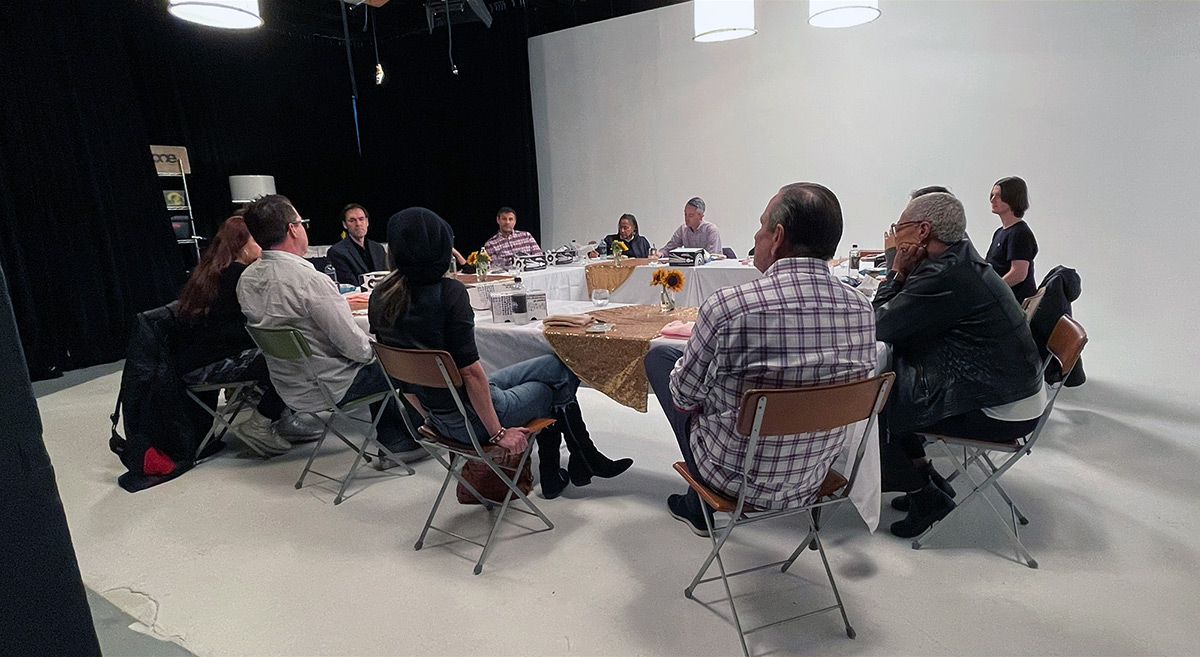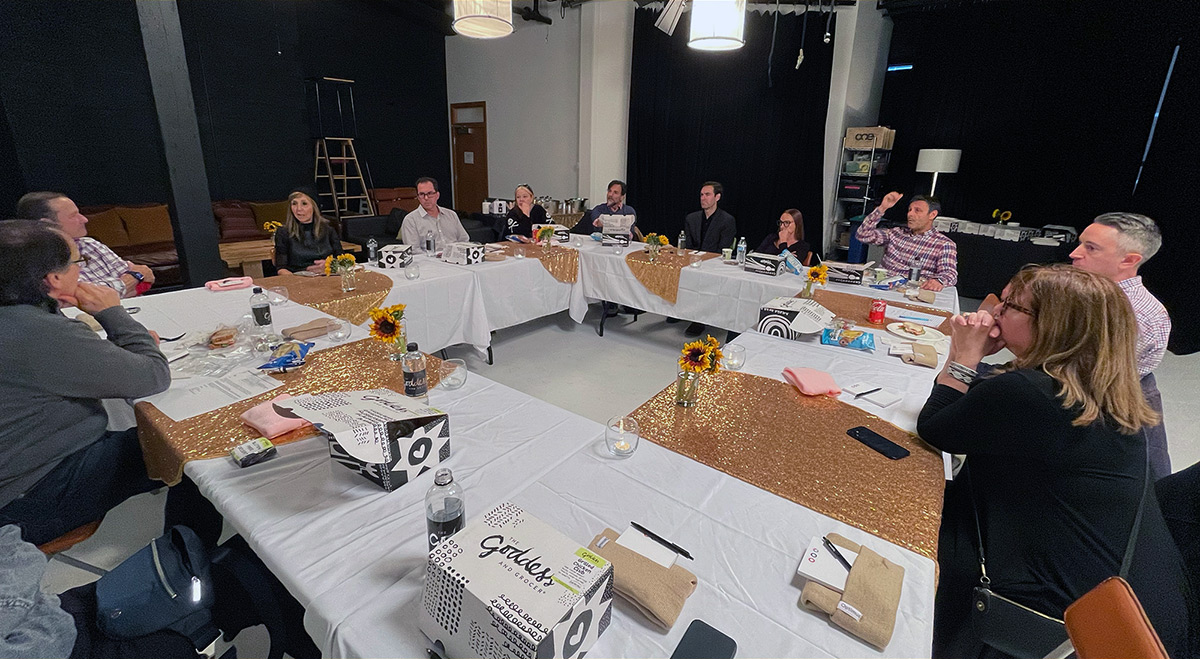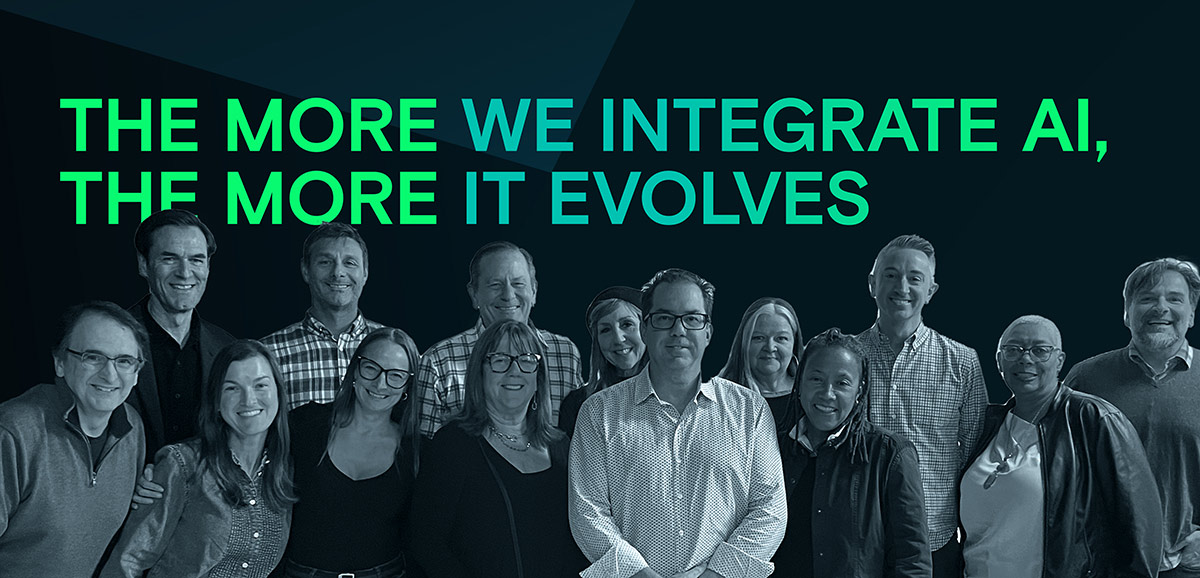As the industry continues to recover from the effects of the pandemic, more and more people are spending time together – whether it’s in the office, at industry events like the national tour for the AICP Awards, in post production sessions and on set for live action production. Add to that list the ongoing series of Simian Advertising Heads of Production roundtables, which resumed in-person gatherings early in November with a meeting of Midwest-based HoPs.
Jointly sponsored by Optimus, and held at their offices in Chicago, over a dozen agency production leaders took part, representing such shops as FCB, OKRP, DDB, Havas, Dentsu, Burrell, Ogilvy and others. The conversation was wide open and free flowing, and it was clear from the interaction that these busy HoPs were enjoying being in each other’s company and eager to know how they’re dealing with a range of pressing issues.

Among the first topics of discussion was – surprise! – the looming impact of AI on all things related to production. We learned that agencies are using it for things like retouching and animatics, and that creatives are using it for pitches and presentations. It’s also being used to create scratch tracks for edits. But most of this would fall into the category of comp or test work. One HoP noted that their agency used AI to recreate a celebrity’s voice for use as a voiceover on a test spot, to show to a client how it would sound.

“People think AI is coming into production and post production, so they’re coming to us,” one person noted. “But the reality is, it’s impacting data and insights, production management, resource management and more.”
When asked if they’re comfortable that they’ll be able to manage the rush of AI into production and post, one said simply, ‘hell, no.’ As another pointed out, “There’s a massive misconception on the part of clients as to what AI can do right now. They’ve heard about some high profile examples, and they’re asking for that, without knowing what went into it, or how much it really cost.” Added another, “I’m seeing this expectation that we’re using it as a production tool, or for post production. It’s just not the case.”
That said, noted one HoP, “there are some tasks it’s performing right now, and as we get more comfortable with it, and we continue to integrate it, it will just keep evolving every day.”

One thing that’s clear is that mastering these technologies will require a new kind of skill set. “Think of it as kind of like asset engineering mixed into our creative process,” said one participant. And the use of AI to churn out the kind of services that agencies are still asked to provide – “tracking assets and deliverables and managing high volume versioning, all that stuff” – is seen as an area where AI can find a warm reception.
Another topic was the push for more sustainable practices, via initiatives such as Green the Bid. Several HoPs noted that it’s been adopted by some big agency networks and brands, although they pointed out that the push for sustainable practices is something that many big advertisers are doing across the full spectrum of their activities.
One HoP cited another initiative, Ad Net Zero, which is similarly driving agencies, clients and the production community to agree on practices designed to cut carbon generation, with an early focus on dialing back air travel. That said, several pointed out that any restrictions or limits on travel have to start at the client level.
Indeed, the need for advertising production to start measuring its carbon footprint on a per-job basis is something that’s looming, one HoP noted. “There are some great carbon calculators out there, and for us, it’s just a matter of time. Unless we start looking at these things, we’re going to get caught off guard, because they’re absolutely coming. If anything, we’re late to the game.”
If travel gets scrutinized, one HoP pointed out, it might limit the ability of junior creatives and producers to get much-needed exposure and experience to the production process. “It also takes a lot of sacrifice and trust from leadership to stop going on the shoots and let the younger people step in, take risks and try and do more. Because otherwise, it feels like we’re not focusing on the growth of those people on our teams.”
This led to a discussion about how it impacts post production, particularly in the area of in-person sessions. Optimus’ Tom Duff, who sat in on the discussion, offered that they’re seeing more and more clients coming into their studios to work directly with their artists and producers, and it’s having an measurable impact. “Everybody can feel the energy in the room,” he pointed out. “And for some of the younger creatives and producers, it’s the first time they’ve been able to sit in sessions. I think it’s invigorating for them, beyond just the mentorship and the experience. Getting to craft the work and brainstorm together, it’s fun. And for us veterans, it feels new again.”
With so much new talent coming into the ranks for directors, editors and artists, how are agency production departments dealing with evaluating this talent and presenting them with opportunities to work on brand assignments? It’s a tricky issue, some suggested. “Resistance actually doesn’t come from the client side, because it often doesn’t get to the client,” one exec said. “It’s more from the creative side. Everyone wants really trusted friends, people they’ve worked with. They want to look at the kids, and we send them the reels, but then they want the comfort level. Often, you can sell it in by saying this production company is solid, they’re standing behind this talent – which is kind of how we’re getting a lot of the newer people in.”
Finally, we talked about something near and dear to us at Simian: showreels! One thing we found out was that agency production heads are not crazy about montages. And if what’s submitted on a reel doesn’t feel quite right, you’ll be lucky to get them to watch for more than a handful of seconds. Display format matters, too. “If someone has a complicated website or reel link, then forget it,” was a comment we heard. Other key elements are brevity, and making sure that the same spot isn’t showing up on reel after reel submitted for different clients.
And then there’s the role that reps play: “If you’re dealing with someone you trust, and you know they’re going to try and tune it in for you and send you their best, then I’ll look at it for sure.”
The conversation touched on other topics as well, everything from the challenge of producing social content to employing in-house content studios to feed clients’ demands for social (hint: no one thinks it’s economically feasible to do on their own) to the trend of setting up separately-branded production entities outside the agencies themselves. Overall, the assembled HoPs suggested that their job descriptions are continuing to expand, as the shape and form of brand content does the same.


